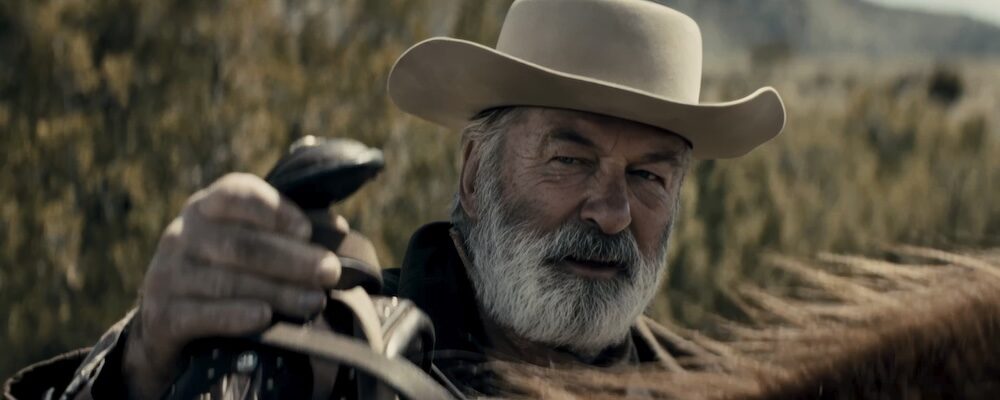‘Rust’: Alec Baldwin Delivers a Performance Weighed by Somberness in a Scattered Western Haunted by Tragedy
Alci Rengifo
Few audience members will venture to see “Rust” unaware this film arrives already haunted by tragedy. Some cinephiles might even wonder if it is appropriate to watch the film with the knowledge that its Ukrainian cinematographer, Halyna Hutchins, was tragically killed in 2021 in a hazy accident involving star Alec Baldwin firing a weapon on set. Director Joel Souza was injured but survived. Manslaughter charges were filed against Baldwin which were later dismissed. Filming resumed 18 months later with cinematographer Bianca Cline taking over for Hutchins. Inevitably, as with any movie stalked by some horrible occurrence, there is an element of morbid curiosity forever attached to it. As a Western, “Rust” attempts to be epic, at 2 hours and 19 minutes, despite the simplicity of its screenplay. In a film where the look demands particular attention, what is never in doubt is that Hutchins’ eye towers over the material.
The plot in hindsight is full of piercing ironies. It’s the 1880s in Wyoming. A 13-year-old named Lucas (Patrick Scott McDermott) scrapes by in a farm where he now lives alone with his younger brother, Jacob (Easton Malcolm), following the death of their mother. Life out here is hard. When Lucas breaks the arm of another rancher’s son who was bullying Jacob, the other boy’s irate father demands Lucas make up for it by working for him to make up for the loss of manpower. It seems Lucas doesn’t have a choice. A cruel twist of fate follows when, while trying to hunt down a local wolf, Lucas accidentally shoots the rancher. He is swiftly separated from Jacob, arrested and condemned to hang. In the night rides in Harland Rust (Baldwin), an aged outlaw who breaks Lucas out of prison and rides off with him. Rust reveals he is the boy’s grandfather, taking him to El Paso where they can cross the border into Mexico. Before long, there is a price on their heads and bounty hunters on their trail.
That “Rust” was finished is in itself a feat. Baldwin, who co-wrote and produced the movie, eventually paid an undisclosed settlement to Hutchins’ surviving family while making her widower, Matthew Hutchins, an executive producer on the film. Then there was the flood of testimonials about set mismanagement and crew members quitting over safety concerns. Hannah Gutierrez-Reed, who worked as prop armorer, is still serving an 18-month prison sentence. “Rust” is condemned to be on the shelf next to movies like “The Crow,” where the notoriety of the tragedy overshadows all other merits. Many of its story elements suddenly gain a more eerie resonance, from the themes of accidental murder to profound reckonings. Baldwin’s performance carries a particular somberness that can be felt beyond the usual enigmatic Western archetype. There is not much energy to it but instead a weighed down weariness. It could very well be an accurate idea of the character as conceived, or an actor powering through to finish this film, his mind on the narrative and the reality beyond the camera.
Story-wise Joel Souza’s screenplay feels too crammed and scattered. Desperate to get in nearly every Western cliché, he can’t focus on one strong plot thread. The story of the grandfather trying to connect with a skeptical grandson (played with admirable tension by McDermott) would have made for an engaging journey. There is a lot of sidewinding going on into subplots involving an ominous bounty hunter they call Preacher (Travis Fimmel), who gets a whole moment with a woman he interrogates for information. Wood Helm (Josh Hopkins) is the sheriff out to get Rust but with a bit more virtue to his job. These stories run parallel while Rust and Lucas come across other symbols of westward expansion, from secluded hunters in fur coats who are clearly going insane to Native Americans always on the watch but willing to make a trade. Not every performance is pristine, at times hampered by amateurish dialogue or choices fit for a VOD release. One suspects that is precisely where “Rust” would have been automatically consigned if not for its notoriety. Though the action scenes and shootouts are staged with craft and don’t linger too much on any carnage.
It is in the visuals where “Rust” carries its greatest, inevitable weight. Understandably, there has been no effort to disclose exactly which shots belong to Hutchins and which belong to Cline. Some film buffs will no doubt devote themselves to finding out. Yet, Hutchins’ style is evident in much of this film’s rich use of silhouettes, widescreen vistas chasing after Terrence Malick and the amber glow of nighttime moments. Take a look at her previous work and short films and you can see how she clearly elevated this material. Even greater projects were no doubt on the horizon for this talented DP. That may be the greatest tribute there will be to Hutchins, by letting her work speak for itself. In that context, the flaws in “Rust” are typical to early films in a cinematographer’s catalog, where they were perfecting their craft in every situation or gig. “Rust” is dedicated to Hutchins and rightfully so. Movies can be preserved for endless time, so what she was capable of will be there as an artistic document in parallel with this title’s unfortunate place in recent film history.
“Rust” releases May 2 in select theaters.

